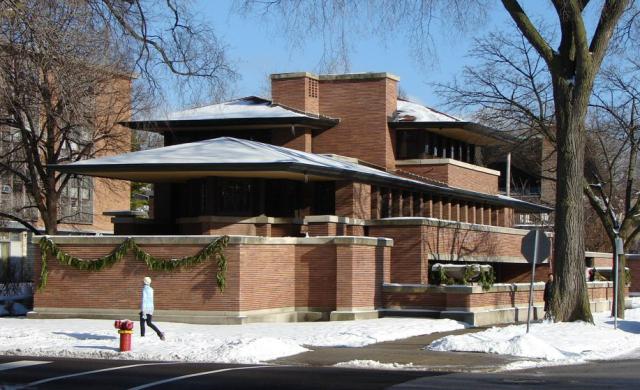Prairie School style

|
| Robie House, Chicago. Architect: Frank Lloyd Wright |
The Prairie style (c.1900-1920) was developed by the American architect, Frank Lloyd Wright. Wright was part of an impressive group of talented architects known as the Prairie School working in Chicago at the turn of the 20th century.
As a student of Louis Sullivan, Wright was part of a creative force which, at the time, was changing the world of architectural design. The period was one of upheaval and growth, and this was reflected in the emerging new building styles.
Wright was especially interested in the design of houses, rather than public buildings, and he became the master of the Prairie style: a new, domestic architectural language designed to complement the terrain and temperament of the Midwestern prairies.
In describing the style Wright said: "The prairie has a beauty of its own and we should recognise and accentuate this natural beauty, its quiet level. Hence, gently sloping roofs, low proportions, quiet skylines, suppressed heavy-set chimneys and sheltering overhangs, low terraces and out-reaching walls sequestering private gardens."
Many other notable architects in Chicago and the Midwest generally designed well-executed Prairie style houses, mostly in that region. The shape and form of the Prairie-style house was distinctly different from previous domestic architecture. Wright wanted to create organic homes with a strong horizontal emphasis that did not resemble the traditional, revival-style houses popular in the past.
The main vernacular form of the Prairie style seen most often is also known as the 'American Foursquare' or 'American Basic'.
American Foursquare houses are generally two storeys in height, square in shape, and have low-pitched, hipped roofs with broad overhangs and symmetrical façades, and broad, front porches with square columns.
Their connection to the Prairie style is seen in the horizontal emphasis created by the roofline of the dominant front porch and the oversailing eaves of the roof itself. These vernacular buildings may also incorporate details from other styles, like Spanish Revival tiled roofs, or Italianate cornice brackets which make their association with the Prairie style more difficult to identify.
As with all vernacular building forms, designation as examples of a specific style may not be appropriate. Like the bungalow-style houses popular in the same period, American Foursquare houses could be ordered in prefabricated kits through mail-order catalogues. This American Foursquare building form, like the bungalow, was a popular and affordable housing choice in the growing suburbs at the beginning of the twentieth century.
Some of the most identifiable features of the Prairie style include:
- Low-pitch hipped roof.
- Wide oversailing eaves.
- Emphasis on horizontal lines.
- Massive square porch columns.
- Paired double-hung windows.
[edit] About this article
This article was written by PHMC -
--Pennsylvania Historical and Museum Commission
[edit] Related articles on Designing Buildings Wiki
- Architectural styles.
- Beaux Arts style.
- Bungalow.
- Chateauesque style.
- Chicago school of architecture.
- Commercial style.
- International Style.
- Modernist architecture.
- Nineteenth century architecture.
- Octagon style.
- Polite architecture.
- Queen Anne style.
- Shingle style architecture.
- Spanish Colonial revival style.
- Stick style.
- Tudor revival style.
- Vernacular architecture.
Featured articles and news
RTPI leader to become new CIOB Chief Executive Officer
Dr Victoria Hills MRTPI, FICE to take over after Caroline Gumble’s departure.
Social and affordable housing, a long term plan for delivery
The “Delivering a Decade of Renewal for Social and Affordable Housing” strategy sets out future path.
A change to adoptive architecture
Effects of global weather warming on architectural detailing, material choice and human interaction.
The proposed publicly owned and backed subsidiary of Homes England, to facilitate new homes.
How big is the problem and what can we do to mitigate the effects?
Overheating guidance and tools for building designers
A number of cool guides to help with the heat.
The UK's Modern Industrial Strategy: A 10 year plan
Previous consultation criticism, current key elements and general support with some persisting reservations.
Building Safety Regulator reforms
New roles, new staff and a new fast track service pave the way for a single construction regulator.
Architectural Technologist CPDs and Communications
CIAT CPD… and how you can do it!
Cooling centres and cool spaces
Managing extreme heat in cities by directing the public to places for heat stress relief and water sources.
Winter gardens: A brief history and warm variations
Extending the season with glass in different forms and terms.
Restoring Great Yarmouth's Winter Gardens
Transforming one of the least sustainable constructions imaginable.
Construction Skills Mission Board launch sector drive
Newly formed government and industry collaboration set strategy for recruiting an additional 100,000 construction workers a year.
New Architects Code comes into effect in September 2025
ARB Architects Code of Conduct and Practice available with ongoing consultation regarding guidance.
Welsh Skills Body (Medr) launches ambitious plan
The new skills body brings together funding and regulation of tertiary education and research for the devolved nation.
Paul Gandy FCIOB announced as next CIOB President
Former Tilbury Douglas CEO takes helm.
UK Infrastructure: A 10 Year Strategy. In brief with reactions
With the National Infrastructure and Service Transformation Authority (NISTA).























